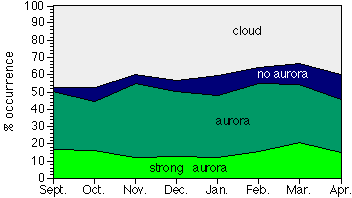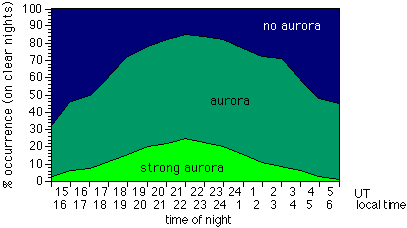

|
| Overview |
| Topical |
| Popular Science |
| Research |
| Observatory |
| Data |
| SEARCH |
| |
| IRF Kiruna |
| IRF Umeå |
| IRF Uppsala |
| IRF Lund |
|
MAP 
|
|
|

|
The night sky is dark enough for the aurora to be seen from about mid-September to early April. This figure shows that you can expect the aurora to be hidden by clouds up to 50% of the time, and that March is the best month to see the aurora (although the difference to the other months is small). The same seasonal variation is seen in magnetometer data. The figure shows the chance of seeing the aurora if you watch for an hour at the time of night when the aurora is most common, i.e. 21-22 UT, 22-23 local time.

The next figure shows the chance of seeing the aurora ( again if you watch for an hour ) if the sky is clear, at different times of the night (average for all months). The same daily variation i seen in magnetic activity.

You can improve your chances of seeing the aurora by taking account of the level of magnetic disturbance.
last updated 20 February 1996Contributors to this page : Peter Amberntsson, Cecilia Arvidsson, Hans Nilsson, Sheila Kirkwood